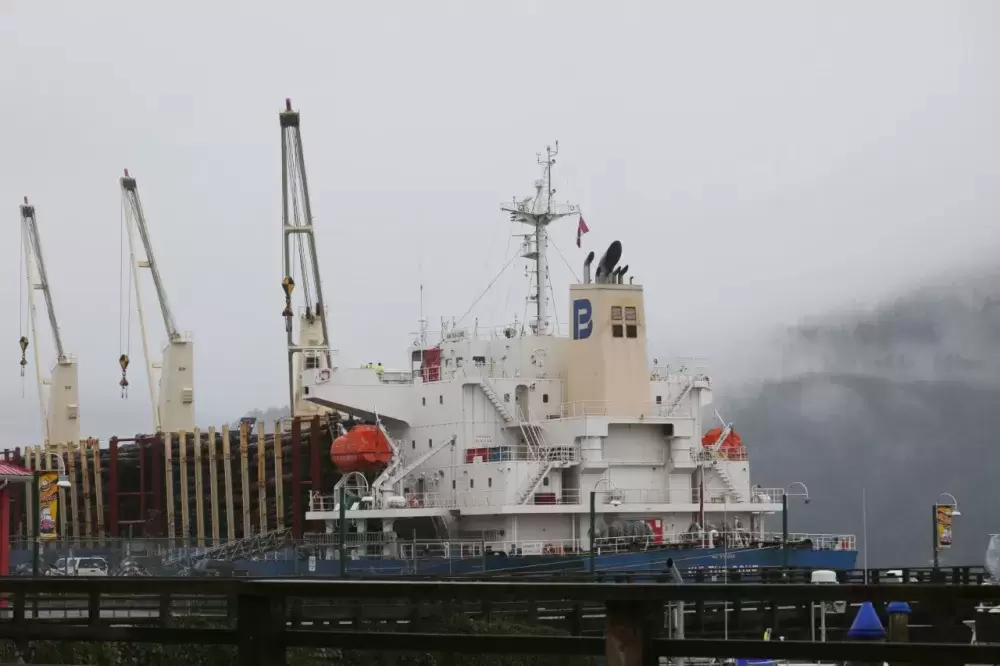In a declining local industry marked by mill closures and a reliance on the export of raw logs for manufacturing overseas, the Huu-ay-aht First Nations plan to nearly triple their forestry workforce.
There are currently 14 people employed in the First Nation’s forestry operations – the most of any in the Huu-ay-aht Group of Companies – but a target has been set to increase this to 36 by 2020, said Chief Councillor Robert Dennis.
This goal comes after the Huu-ay-aht announced the purchase of a seven per cent tenure ownership in Tree Farm Licence 44 from Western Forest Products in December. The $7.2 million acquisition is tied to a limited partnership between the two parties affecting land in Huu-ay-aht traditional territory near Barkley Sound.
With a pledge to revitalize forestry in the region, the partnership followed a reconciliation protocol agreement signed between the Huu-ay-aht and WFP in early 2018, as well as the First Nation’s purchase of the Sarita Bay Log Sort from Western in 2017 for $3 million. This deal also entailed the long-term lease of the log sort back to WFP, an agreement to harvest 200,000 cubic metres from Huu-ay-aht lands, as well as employment and training opportunities for the First Nation’s members.
Dennis envisions a union operation on Huu-ay-aht treaty land.
“We need to get the milling operations operating again,” he said. “It’s a personal initiative that I’ve been pursuing because I remember when we almost had a milling operation going, maybe about 20 years ago. We had all kinds of our people applying for jobs if that milling operation was to open.”
Up the Alberni Inlet the decline of the region’s forestry industry has left its mark on Port Alberni, which has seen a series of mill shutdowns over the last generation. The most recent casualty for the community was the closure of the Western Forest Product’s Somass Mill in 2017, leaving over 70 people out of work. Now Alberni Pacific Division is WFP’s only remaining sawmill in Port Alberni.
The lack of local manufacturing capacity translated into no lumber shipments from Port Alberni’s docks last year, according to the Port Alberni Port Authority’s records. Since 2014 an average of one shipment of manufactured lumber left the city’s port a month, but this dropped to zero in 2018. Over this same time period the number of raw log shipments to overseas mills declined from 54 to 17.
At one time the number of manufactured lumber shipments from Port Alberni actually exceeded vessels loaded with raw logs, making this a frustrating trend for many in the area. In January Premier John Horgan announced plans to “reverse a systematic decline” in the forestry sector through measures to increase the processing of logs on B.C.’s coast and reduce the amount of discarded timber left on cutblocks.
Among these measures are revisions to the Timber Export Advisory Committee to include more First Nations members and new raw log export fees.
“A ‘fee-in-lieu of manufacturing’ is charged to log exporters,” stated B.C.’s Ministry of Forests, Lands, Natural Resource Operations and Rural Development in a release issued Jan. 17. “The fee is based on the species of log and its quality. A new fee structure based on harvest economics is being developed, which will come into effect summer 2019.”
B.C.’s Forest Act, introduced in 1912, actually requires that timber be manufactured domestically. But there are exemptions if no local mills bid on advertised quantities bound for export, a dynamic that has become commonplace in Port Alberni.
“If there is no domestic buyer, then those logs are provided an exemption,” stated the Ministry of Forests. “Should a domestic buyer put an offer on these logs, the minister’s Timber Export Advisory Committee will determine if offers reflect fair domestic market value and provide recommendations to the minister on each application regarding whether an exemption should be provided.”
Every two weeks forestry companies across the province post their volumes of logs destined for export – unless a B.C. mill can produce an economical bid. On Jan. 30 this list included over 16,000 cubic metres of second growth logged by Island Timberlands near Port Alberni, plus almost 300 cubic metres of old growth harvested in the area.
Dennis said the Huu-ay-aht plan to look into the raw log export issue, and the difficulty local mills have making bids on fibre that often ends up in Asian manufacturing facilities.
“It’s a topic in our community, the desire to reduce our export, the message has been sent to us,” he said. “There’s quite a significant higher price for export logs, that’s the main thing that we’ll have to deal with.”
The province has also pledged to cut the amount of timber left behind on cutblocks with the Coast Forest Sector Revitalization Initiative. Before 2003 wood waste left behind accounted for less than five per cent of the harvest volume, totally approximately 0.8 cubic metres annually, according to the Ministry of Forests. But by 2017 this discarded wood grew to 16 per cent of the harvest, or an estimated two million cubic metres - and in some cutbocks more harvested wood was left behind than taken for use.
Where “enhanced fibre recovery is economical” zones will be designated on Vancouver Island.
“In this geographic area, significant penalties will be applied for any avoidable waste fibre left in harvest areas that exceeds the new lower waste benchmarks that are being introduced,” stated the ministry.
Huu-ay-aht aim to play a larger role in the region’s forestry in a sustainable manner by balancing economic benefits with the First Nation’s communal and territorial needs.
“We’re looking at the soil, we’re looking at the wildlife…that’s how we apply hišuk ma c̕awak, everything is one,” he said. “We’re respecting Huu-ay-aht culture and traditions by applying these in our forest management practices.”







